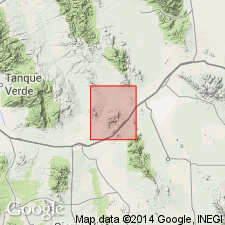
- Usage in publication:
-
- Texas Canyon Quartz Monzonite*
- Modifications:
-
- Named
- Dominant lithology:
-
- Quartz monzonite
- AAPG geologic province:
-
- Pedregosa basin
Summary:
Pg. 78-81, pl. 1. Texas Canyon Quartz Monzonite. Thought to be a stock-type body; outcrop area is roughly 4 x 6.5 miles; long axis trends northeast. Is divisible into a porphyritic, nonporphyritic, and sheared facies. Intrudes rocks as young as Early Cretaceous Bisbee Group. For about 4.5 miles along northwestern side of the stock, the quartz monzonite has invaded Pinal schist and has steep arcuate contact that tends to be concordant with bedding and foliation in the schist. This relatively smooth part of contact ends where quartz monzonite has intruded younger rocks. About 1 mile southwest of Johnson, where quartz monzonite has intruded Apache group, the contact turns to southeast and becomes discordant and irregular. At lower end of Sheep Basin the quartz monzonite has invaded thrust sheets of Paleozoic and Cretaceous rocks. Large masses of aplite have been intruded along this part of contact. Much of intrusive contact on east and south is concealed by overlapping alluvium. Northeast of Lancha the quartz monzonite cuts folded and thrust-faulted rocks ranging from Pinal schist to Morita and Cintura formations, and contact is discordant and irregular. Age is early Tertiary(?); corresponds in age to Stronghold Granite. Report includes geologic map.
Forms much of eastern half of Little Dragoon Mountains. Named from exposures in Texas Canyon through which Highway 86 [now I-10] passes, in T. 16 S., R. 22 E., Dragoon quadrangle, Cochise Co., southeastern AZ (Pedregosa basin). [According to GNU records (USGS DDS-6; Denver GNULEX, April 8, 1986), type locality not designated.]
Source: US geologic names lexicon (USGS Bull. 1350, p. 754-755); supplemental information from GNU records (USGS DDS-6; Denver GNULEX).
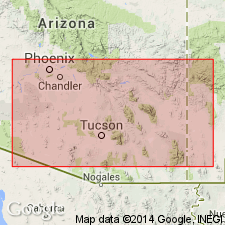
- Usage in publication:
-
- Texas Canyon Granite
- Modifications:
-
- Geochronologic dating
- AAPG geologic province:
-
- Pedregosa basin
Summary:
Texas Canyon Granite. K-Ar age 54 Ma. [Early Tertiary age adopted by the GNC, following recommendation of C.A. Anderson.]
Source: Modified from GNU records (USGS DDS-6; Denver GNULEX).
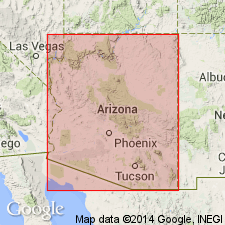
- Usage in publication:
-
- Texas Canyon Granite
- Modifications:
-
- Age modified
- Geochronologic dating
- AAPG geologic province:
-
- Pedregosa basin
Summary:
Texas Canyon Granite. K-Ar age 54 Ma. [Early Tertiary age adopted by the GNC, following recommendation of C.A. Anderson.]
Source: Modified from GNU records (USGS DDS-6; Denver GNULEX).

- Usage in publication:
-
- Texas Canyon Quartz Monzonite*
- Modifications:
-
- Age modified
- Geochronologic dating
- AAPG geologic province:
-
- Basin-and-Range province
Summary:
Texas Canyon Quartz Monzonite. Samples from Little Dragoon Mountains, Lat. 32 deg. 06 min. N., Long. 110 deg. 05 min. W., Cochise County, Arizona, yielded K-Ar ages of 52 +/-3 Ma and 50 +/-3 Ma (biotite). Age changed from early Tertiary --to-- Eocene.
Source: Modified from GNU records (USGS DDS-6; Denver GNULEX).

- Usage in publication:
-
- Texas Canyon Quartz Monzonite*
- Modifications:
-
- Age modified
- AAPG geologic province:
-
- Pedregosa basin
Summary:
Texas Canyon Quartz Monzonite. In southeastern Arizona, age is late Paleocene (50 Ma). Assigned to early Tertiary in previous reports.
Source: Modified from GNU records (USGS DDS-6; Denver GNULEX).
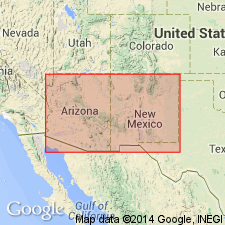
- Usage in publication:
-
- Texas Canyon Quartz Monzonite*
- Modifications:
-
- Age modified
- Geochronologic dating
- AAPG geologic province:
-
- Pedregosa basin
Summary:
Texas Canyon Quartz Monzonite. Samples from Little Dragoon Mountains and vicinity, Cochise County, Arizona, yielded K-Ar ages (biotite) of 53 +/-3 Ma and 51 +/-3 Ma (recalculated). Age is changed from late Paleocene --to-- early Eocene. Samples previously published by Marvin and others (1973).
Source: Modified from GNU records (USGS DDS-6; Denver GNULEX).
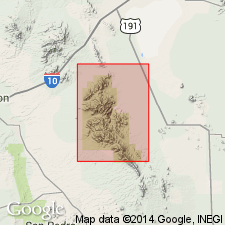
- Usage in publication:
-
- Texas Canyon Quartz Monzonite*
- Modifications:
-
- Mapped 1:24k
- Dominant lithology:
-
- Granitic rock
- AAPG geologic province:
-
- Pedregosa basin
Summary:
Texas Canyon Quartz Monzonite, altered phase. Aplitic, pale-yellowish-brown granitic rock at border of large stock in northwest corner of map area. Samples reported by Marvin and others (1973) yielded K-Ar ages of 52 +/-3 Ma and 50 +/-3 Ma (biotite); rocks of this age previously assigned to the Paleocene are now considered early Eocene.
Source: Publication.
For more information, please contact Nancy Stamm, Geologic Names Committee Secretary.
Asterisk (*) indicates published by U.S. Geological Survey authors.
"No current usage" (†) implies that a name has been abandoned or has fallen into disuse. Former usage and, if known, replacement name given in parentheses ( ).
Slash (/) indicates name conflicts with nomenclatural guidelines (CSN, 1933; ACSN, 1961, 1970; NACSN, 1983, 2005, 2021). May be explained within brackets ([ ]).

